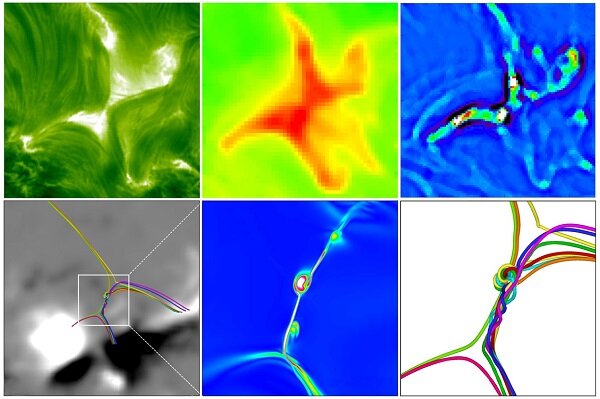A joint research team has found the formation of magnetic islands with the twisted structure in the current sheet during the fast magnetic reconnection for the first time.
The findings were published in Nature Communications on Feb. 2.
The study was conducted by researchers from Yunnan Observatories of the Chinese Academy of Sciences (CAS), Harbin Institute of Technology, University of Potsdam, University of St Andrews, National Astronomical Observatories of CAS, and National Space Science Center of CAS.
Magnetic reconnection is an important process of energy release on the sun. It is a focus of astronomy, space science, and laboratory plasma research. However, the detailed process of magnetic reconnection is still not clear.
Using high temporal and spatial resolution observations of the New Vacuum Solar Telescope (NVST), combined with ultraviolet (UV) and extreme ultraviolet (EUV) images, and vector magnetograms observed by Solar Dynamics Observatory (SDO), spectra from Hinode, as well as the X-ray data from Reuven Ramaty High Energy Solar Spectroscopic Imager (RHESSI) and Geostationary Operational Environmental Satellites (GOES), the researchers studied in detail the process of the magnetic reconnection during a confined solar flare in active region NOAA 11967 on February 02, 2014.
They found that the magnetic reconnection occurred between a twisted magnetic flux rope enveloping a filament and magnetic loops rooting in the near chromospheric fibrils.
The most complete observational evidences of magnetic reconnection so far were observed in this event, including reconnection inflows and outflows, the newly formed magnetic loops, current sheet, hot cusp-shaped structures, downflows, and so on. The estimated reconnection rate ranged from 0.01 to 0.03, which belonged to fast magnetic reconnection.
From EUV observations, they found that the plasmoids formed in the current sheet and moved to the two ends of the current sheet. By using vector magnetic fields from SDO/HMI, they also carried out the data-driven simulation. The results showed that plasmoids formed in the current sheet and confirmed that the plasmoids were the mini twisted flux ropes.
This research reveals the fine process of a fast magnetic reconnection, which deepens our understanding of the basic process of magnetic reconnection. Moreover, this study provides guidelines for eruptive activities in other objects (sun-like stars, neutron stars, and black holes), magnetic dissipation in astronomy, space science and laboratory plasma.
More information:
Xiaoli Yan et al, Fast plasmoid-mediated reconnection in a solar flare, Nature Communications (2022). DOI: 10.1038/s41467-022-28269-w
Provided by
Chinese Academy of Sciences
Citation:
Researchers reveal 3D structure and evolution of magnetic islands in fast magnetic reconnection (2022, February 10)
